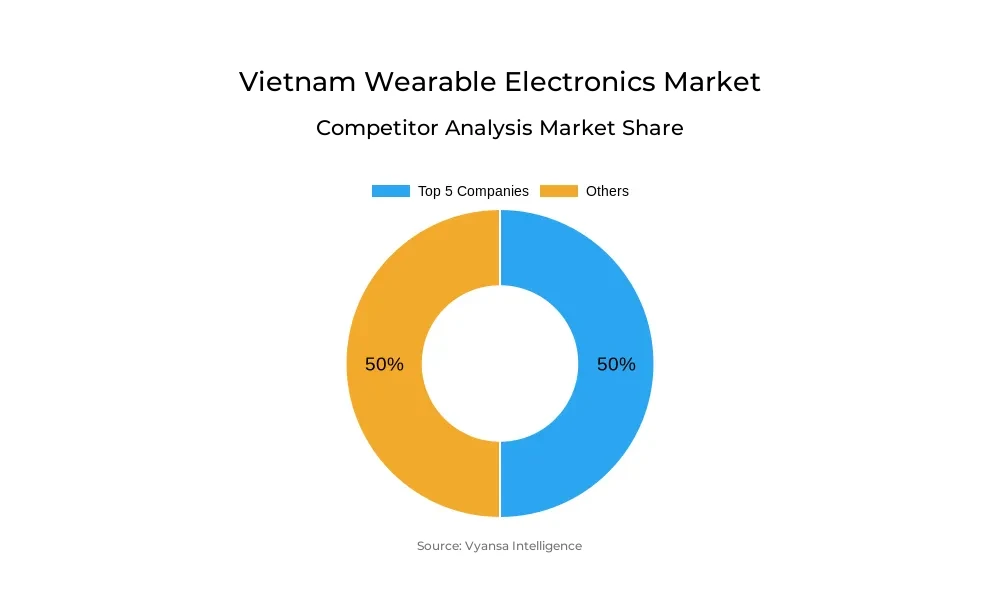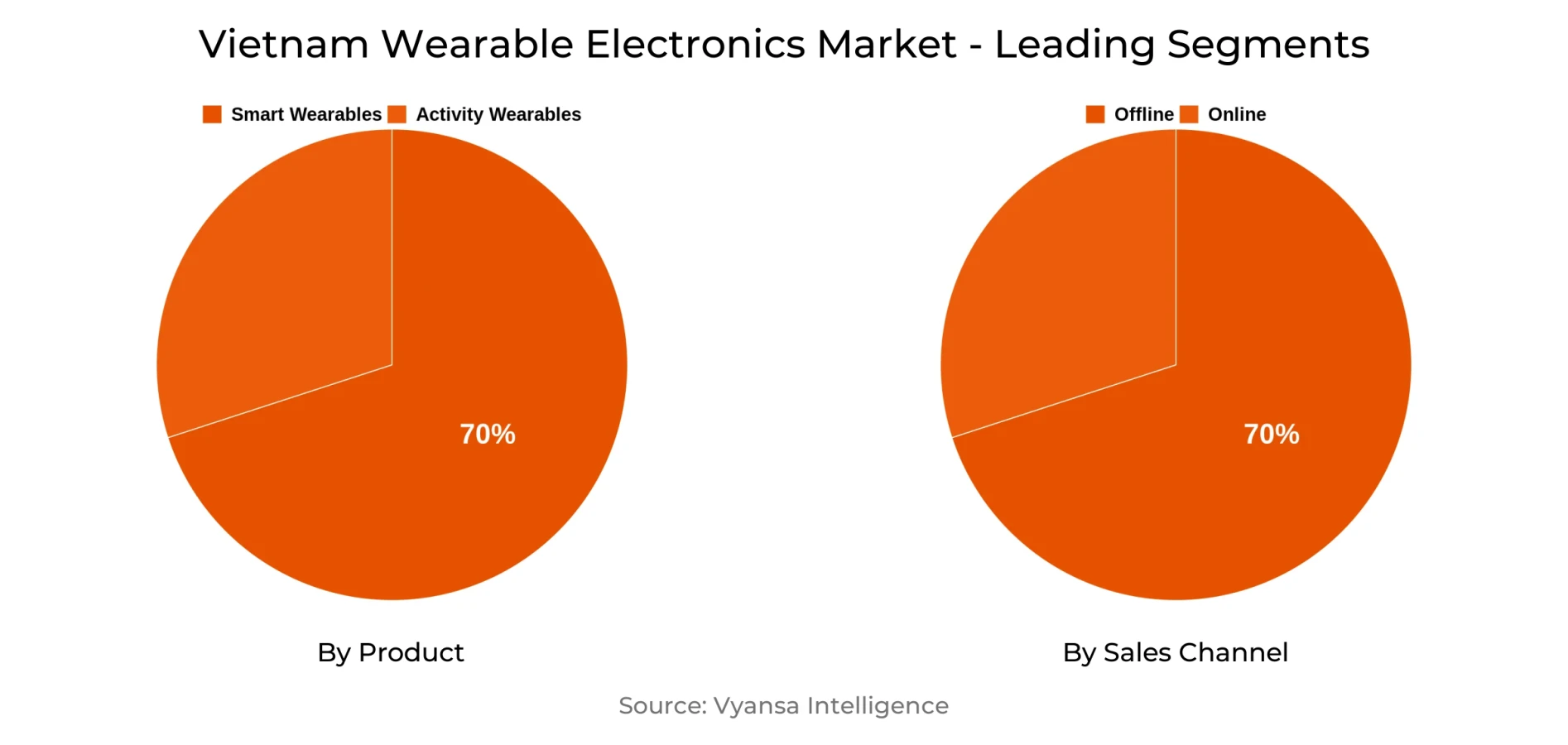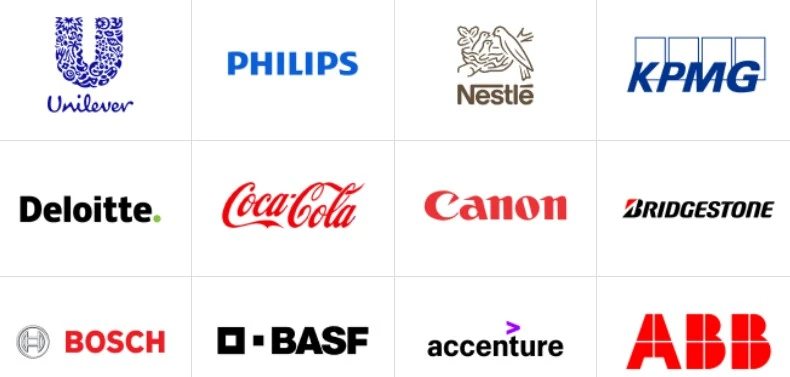Vietnam Wearable Electronics Market Report: Trends, Growth and Forecast (2025-2030)
By Product (Activity Wearables, Smart Wearables), By Application (Healthcare, Entertainment, Industrial, Others), By Sales Channel (Offline, Online)
- FMCG
- Dec 2025
- VI0075
- 128
-




Vietnam Wearable Electronics Market Statistics, 2025
- Market Size Statistics
- Wearable Electronics in Vietnam is estimated at $ 565 Million.
- The market size is expected to grow to $ 985 Million by 2030.
- Market to register a CAGR of around 9.71% during 2025-30.
- Product Shares
- Smart Wearables grabbed market share of 70%.
- Smart Wearables to witness a volume CAGR of around 5.34%.
- Competition
- More than 10 companies are actively engaged in producing Wearable Electronics in Vietnam.
- Top 5 companies acquired 50% of the market share.
- Fossil Group Inc, Garmin Ltd., Huawei Technologies Co., Ltd., Xiaomi Corp, Apple Inc etc., are few of the top companies.
- Sales Channel
- Retail Offline grabbed 70% of the market.
Vietnam Wearable Electronics Market Outlook
Vietnam wearable electronics market is set to experience sustained growth in 2025–2030, driven by increasing income levels, enhanced living standards, and increasing knowledge of day-to-day health and wellness. Smart wearables will remain in demand for their real-time monitoring of health, with customers appreciating their ease of use and seamless integration into daily routines. With preventive healthcare becoming increasingly popular, these products are likely to be a key part of maintaining personal well-being.
While demand in the lower-end to mid-range segments can be sluggish owing to growing consumer pickiness, the premium segment is expected to increase further with interest in high-end features and fashionable designs. The ageing population will also contribute significantly towards market growth as older consumers opt for smartwatches with health monitoring, SOS, and Vietnamese voice control. In addition, increasing income and web adoption in rural regions will assist in expanding the consumer base, while brand recognition for products such as the Apple Watch and Samsung wearables continues to increase.
Retail distribution will remain healthy with specialist electronics outlets such as Mobile World JSC and FPT Shop, which offer customers experiential learning and personalized guidance. These outlets also offer aftersales services and special discounts. Nevertheless, online platforms such as Shopee, Lazada, and TikTok Shop are likely to pick up more share, providing convenience and competitive pricing for those consumers with particular brand choices.
Even as innovation slows and competition from health apps for smartphones rises, the Vietnam wearable electronics market is poised for steady growth with health and fitness trends, technological fascination, and changing consumer needs fueling demand across various user segments.

Vietnam Wearable Electronics Market Growth Driver
As incomes have risen and living standards have improved, consumers in Vietnam are becoming more concerned with everyday health and wellbeing. This has resulted in stable demand for smart wearables because they provide real-time tracking of health and fitness metrics and encourage users to take healthier lifestyles. The convenience and feasibility of incorporating these devices into everyday lifestyle easily make them most desirable. With increasing awareness of preventive healthcare, intelligent wearables are likely to become a must-have for those who want to get in charge of their well-being.
While this is happening, rural regions offer untapped growth opportunities, fueled by increasing incomes and expanding internet penetration. Greater online engagement is enhancing brand recognition and making online purchases more convenient. Additionally, products from premier brands such as Apple and Samsung are also considered trendy accessories, allowing users to express their personalities while availing health features.
Vietnam Wearable Electronics Market Opportunity
Vietnam is among the world's fastest-ageing nations, presenting a precious market for wearable electronics specifically for older consumers. Smartwatches for the segment are forecast to witness increasing demand, providing GPS tracking, SOS calls, caregiver remote monitoring, and Vietnamese voice control. These features are intended to enhance safety and independence among the elderly while providing reassurance to their caregivers and families.
With most ageing users having one or more medical conditions, smartwatches with medical-grade sensors are increasingly becoming essential. Capabilities such as tracking the blood oxygen level, ECG, blood glucose, and reminders for medication can enable users to better control chronic diseases. Such features not only contribute to improved health results but can also serve as early warning systems, further increasing adoption among Vietnam's elderly population.
| Report Coverage | Details |
|---|---|
| Market Forecast | 2025-30 |
| USD Value 2024 | $ 565 Million |
| USD Value 2030 | $ 985 Million |
| CAGR 2025-2030 | 9.71% |
| Largest Category | Smart Wearables segment leads with 70% market share |
| Top Drivers | Rising Health Awareness and Lifestyle Aspirations Fuel Market Stability |
| Top Opportunities | Expanding Reach Through Elderly-Focused Innovations |
| Key Players | Fossil Group Inc, Garmin Ltd., Huawei Technologies Co., Ltd., Xiaomi Corp, Apple Inc, Samsung Vina Electronics Co Ltd, U Watch (HK) Co Ltd, Fitbit Inc, Withings, Zepp Health Corporation and Others. |
Vietnam Wearable Electronics Market Segmentation Analysis

The most prominent market segment of Vietnam Wearable Electronics Market for the period 2025-30 is smart wearables. They have become reliable health and fitness buddies, providing facilities such as heart rate monitoring, sleep tracking, exercise analysis, and stress management tools. Advanced sensors and algorithms create practical insights for users into their overall well-being. Vietnamese consumers look for stylish, compact smart wearables with good wearing comfort, particularly those that can be used during exercise when people sweat. Easy-to-wipe products and those utilizing antibacterial materials are also attracting attention for improved cleanliness.
Children's smart wearables are also gaining increased interest, especially from parents who wish to track their child's location, activity level, and health. In this market, animation-themed fun designs on wearables and soft, skin-comforting materials are demanded. But affordability should remain, as children are prone to losing or breaking their devices while playing.
Top Companies in Vietnam Wearable Electronics Market
The top companies operating in the market include Fossil Group Inc, Garmin Ltd., Huawei Technologies Co., Ltd., Xiaomi Corp, Apple Inc, Samsung Vina Electronics Co Ltd, U Watch (HK) Co Ltd, Fitbit Inc, Withings, Zepp Health Corporation, etc., are the top players operating in the Vietnam Wearable Electronics Market.
Frequently Asked Questions
Related Report
1. Market Segmentation
1.1. Research Scope
1.2. Research Methodology
1.3. Definitions and Assumptions
2. Executive Summary
3. Vietnam Wearable Electronics Market Policies, Regulations, and Standards
4. Vietnam Wearable Electronics Market Dynamics
4.1. Growth Factors
4.2. Challenges
4.3. Trends
4.4. Opportunities
5. Vietnam Wearable Electronics Market Statistics, 2020-2030F
5.1. Market Size & Growth Outlook
5.1.1.By Revenues in US$ Million
5.1.2.By Unit Sold (Thousand Units)
5.2. Market Segmentation & Growth Outlook
5.2.1.By Product
5.2.1.1. Activity Wearables- Market Insights and Forecast 2020-2030, USD Million
5.2.1.1.1. Activity Bands- Market Insights and Forecast 2020-2030, USD Million
5.2.1.1.2. Activity Watch- Market Insights and Forecast 2020-2030, USD Million
5.2.1.1.2.1. Analogue- Market Insights and Forecast 2020-2030, USD Million
5.2.1.1.2.2. Digital- Market Insights and Forecast 2020-2030, USD Million
5.2.1.2. Smart Wearables- Market Insights and Forecast 2020-2030, USD Million
5.2.1.2.1. Eye Wear- Market Insights and Forecast 2020-2030, USD Million
5.2.1.2.2. Body Wear- Market Insights and Forecast 2020-2030, USD Million
5.2.2.By Application
5.2.2.1. Healthcare- Market Insights and Forecast 2020-2030, USD Million
5.2.2.2. Entertainment- Market Insights and Forecast 2020-2030, USD Million
5.2.2.3. Industrial- Market Insights and Forecast 2020-2030, USD Million
5.2.2.4. Others- Market Insights and Forecast 2020-2030, USD Million
5.2.3.By Sales Channel
5.2.3.1. Offline- Market Insights and Forecast 2020-2030, USD Million
5.2.3.2. Online- Market Insights and Forecast 2020-2030, USD Million
5.2.4.By Competitors
5.2.4.1. Competition Characteristics
5.2.4.2. Market Share & Analysis
6. Vietnam Activity Wearable Electronics Market Statistics, 2020-2030F
6.1. Market Size & Growth Outlook
6.1.1.By Revenues in US$ Million
6.1.2.By Unit Sold (Thousand Units)
6.2. Market Segmentation & Growth Outlook
6.2.1.By Product- Market Insights and Forecast 2020-2030, USD Million
6.2.2.By Application- Market Insights and Forecast 2020-2030, USD Million
6.2.3.By Sales Channel- Market Insights and Forecast 2020-2030, USD Million
7. Vietnam Smart Wearable Electronics Market Statistics, 2020-2030F
7.1. Market Size & Growth Outlook
7.1.1.By Revenues in US$ Million
7.1.2.By Unit Sold (Thousand Units)
7.2. Market Segmentation & Growth Outlook
7.2.1.By Product- Market Insights and Forecast 2020-2030, USD Million
7.2.2.By Application- Market Insights and Forecast 2020-2030, USD Million
7.2.3.By Sales Channel- Market Insights and Forecast 2020-2030, USD Million
8. Competitive Outlook
8.1. Company Profiles
8.1.1.Xiaomi Corp
8.1.1.1. Business Description
8.1.1.2. Product Portfolio
8.1.1.3. Collaborations & Alliances
8.1.1.4. Recent Developments
8.1.1.5. Financial Details
8.1.1.6. Others
8.1.2.Apple Inc
8.1.2.1. Business Description
8.1.2.2. Product Portfolio
8.1.2.3. Collaborations & Alliances
8.1.2.4. Recent Developments
8.1.2.5. Financial Details
8.1.2.6. Others
8.1.3.Samsung Vina Electronics Co Ltd
8.1.3.1. Business Description
8.1.3.2. Product Portfolio
8.1.3.3. Collaborations & Alliances
8.1.3.4. Recent Developments
8.1.3.5. Financial Details
8.1.3.6. Others
8.1.4.U Watch (HK) Co Ltd
8.1.4.1. Business Description
8.1.4.2. Product Portfolio
8.1.4.3. Collaborations & Alliances
8.1.4.4. Recent Developments
8.1.4.5. Financial Details
8.1.4.6. Others
8.1.5.Fitbit Inc
8.1.5.1. Business Description
8.1.5.2. Product Portfolio
8.1.5.3. Collaborations & Alliances
8.1.5.4. Recent Developments
8.1.5.5. Financial Details
8.1.5.6. Others
8.1.6.Fossil Group Inc
8.1.6.1. Business Description
8.1.6.2. Product Portfolio
8.1.6.3. Collaborations & Alliances
8.1.6.4. Recent Developments
8.1.6.5. Financial Details
8.1.6.6. Others
8.1.7.Garmin Ltd.
8.1.7.1. Business Description
8.1.7.2. Product Portfolio
8.1.7.3. Collaborations & Alliances
8.1.7.4. Recent Developments
8.1.7.5. Financial Details
8.1.7.6. Others
8.1.8.Huawei Technologies Co., Ltd.
8.1.8.1. Business Description
8.1.8.2. Product Portfolio
8.1.8.3. Collaborations & Alliances
8.1.8.4. Recent Developments
8.1.8.5. Financial Details
8.1.8.6. Others
8.1.9.Withings
8.1.9.1. Business Description
8.1.9.2. Product Portfolio
8.1.9.3. Collaborations & Alliances
8.1.9.4. Recent Developments
8.1.9.5. Financial Details
8.1.9.6. Others
8.1.10. Zepp Health Corporation
8.1.10.1. Business Description
8.1.10.2. Product Portfolio
8.1.10.3. Collaborations & Alliances
8.1.10.4. Recent Developments
8.1.10.5. Financial Details
8.1.10.6. Others
9. Disclaimer
| Segment | Sub-Segment |
|---|---|
| By Product |
|
| By Application |
|
| By Sales Channel |
|
Research Methodology
This study followed a structured approach comprising four key phases to assess the size and scope of the electro-oxidation market. The process began with thorough secondary research to collect data on the target market, related markets, and broader industry context. These findings, along with preliminary assumptions and estimates, were then validated through extensive primary research involving industry experts from across the value chain. To calculate the overall market size, both top-down and bottom-up methodologies were employed. Finally, market segmentation and data triangulation techniques were applied to refine and validate segment-level estimations.
Secondary Research
The secondary research phase involved gathering data from a wide range of credible and published sources. This step helped in identifying industry trends, defining market segmentation, and understanding the market landscape and value chain.
Sources consulted during this phase included:
- Company annual reports, investor presentations, and press releases
- Industry white papers and certified publications
- Trade directories and market-recognized databases
- Articles from authoritative authors and reputable journals
- Gold and silver standard websites
Secondary research was critical in mapping out the industry's value chain and monetary flow, identifying key market segments, understanding regional variations, and tracking significant industry developments.
Other key sources:
- Financial disclosures
- Industry associations and trade bodies
- News outlets and business magazines
- Academic journals and research studies
- Paid industry databases
Primary Research
To validate secondary data and gain deeper market insights, primary research was conducted with key stakeholders across both the supply and demand sides of the market.
On the demand side, participants included decision-makers and influencers from end-user industries—such as CIOs, CTOs, and CSOs—who provided first-hand perspectives on market needs, product usage, and future expectations.
On the supply side, interviews were conducted with manufacturers, industry associations, and institutional participants to gather insights into current offerings, product pipelines, and market challenges.
Primary interviews provided critical inputs such as:
- Market size and revenue data
- Product and service breakdowns
- Market forecasts
- Regional and application-specific trends
Stakeholders consulted included:
- Leading OEM and solution providers
- Channel and distribution partners
- End users across various applications
- Independent consultants and industry specialists
Market Size Estimation and Data Triangulation
- Identifying Key Market Participants (Secondary Research)
- Goal: To identify the major players or companies in the target market. This typically involves using publicly available data sources such as industry reports, market research publications, and financial statements of companies.
- Tools: Reports from firms like Gartner, Forrester, Euromonitor, Statista, IBISWorld, and others. Public financial statements, news articles, and press releases from top market players.
- Extracting Earnings of Key Market Participants
- Goal: To estimate the earnings generated from the product or service being analyzed. This step helps in understanding the revenue potential of each market player in a specific geography.
- Methods: Earnings data can be gathered from:
- Publicly available financial reports (for listed companies).
- Interviews and primary data sources from professionals, such as Directors, VPs, SVPs, etc. This is especially useful for understanding more nuanced, internal data that isn't publicly disclosed.
- Annual reports and investor presentations of key players.
- Data Collation and Development of a Relevant Data Model
- Goal: To collate inputs from both primary and secondary sources into a structured, data-driven model for market estimation. This model will incorporate key market KPIs and any independent variables relevant to the market.
- Key KPIs: These could include:
- Market size, growth rate, and demand drivers.
- Industry-specific metrics like market share, average revenue per customer (ARPC), or average deal size.
- External variables, such as economic growth rates, inflation rates, or commodity prices, that could affect the market.
- Data Modeling: Based on this data, the market forecasts are developed for the next 5 years. A combination of trend analysis, scenario modeling, and statistical regression might be used to generate projections.
- Scenario Analysis
- Goal: To test different assumptions and validate how sensitive the market is to changes in key variables (e.g., market demand, regulatory changes, technological disruptions).
- Types of Scenarios:
- Base Case: Based on current assumptions and historical data.
- Best-Case Scenario: Assuming favorable market conditions, regulatory environments, and technological advancements.
- Worst-Case Scenario: Accounting for adverse factors, such as economic downturns, stricter regulations, or unexpected disruptions.
Partnering With Industry Leaders to Drive Growth
Our mission is to deliver intelligence that matters. By combining data, analysis, and industry expertise, we enable organizations to make smarter, faster, and more impactful decisions. Whether it’s a Fortune 500 company or a high-growth startup, businesses trust us to provide clarity in an ever-evolving marketplace.






